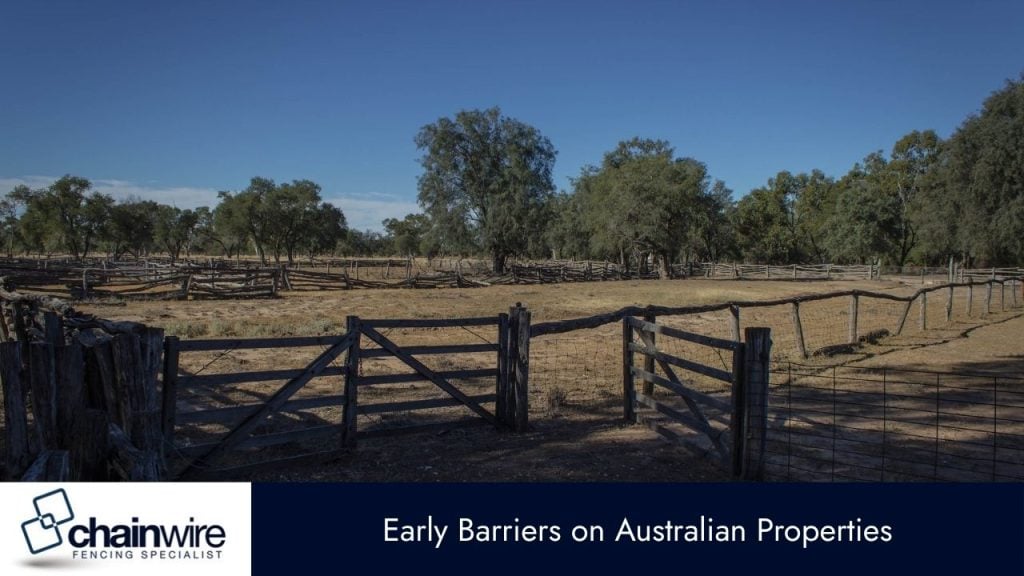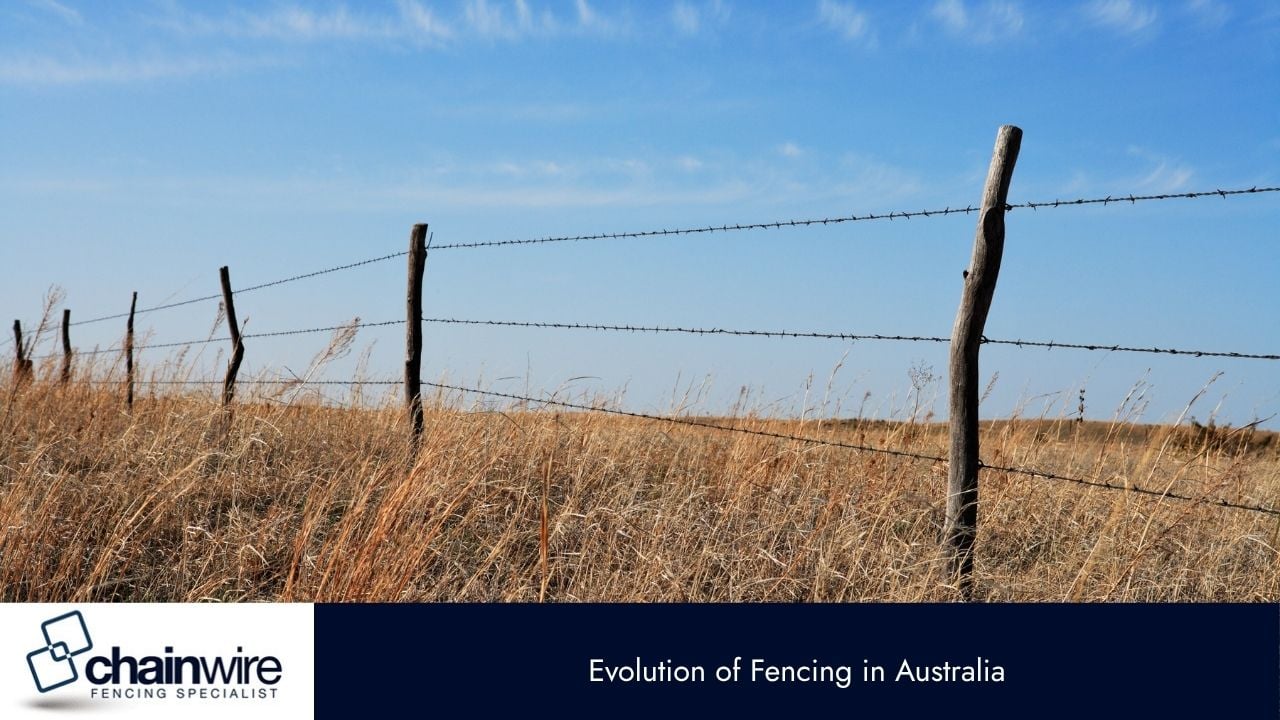Early Australian settlers needed a way to control livestock and protect crops. Open paddocks and unfenced land made it easy for animals to escape or wander into neighbouring areas.
Without clear boundaries, livestock losses were common. Property disputes grew as more land was cleared, and manual supervision wasn’t realistic across wide distances.
Fencing became the practical answer. It helped define land, reduce stock movement, and prevent conflict. What started with timber posts and rails later developed into barbed wire and chainwire mesh—each suited to different land uses across Australia.
Early Barriers on Australian Properties
Before fencing materials were widely available, early landholders relied on whatever they could source. In many regions, this meant using cleared timber, brush, and even stone piles to control livestock movement or mark land boundaries.
These makeshift barriers were time-consuming to build and offered limited reliability. But they helped reduce animal loss and provided a sense of ownership on remote properties where surveyed lines were still being established.
Settlers in rural areas often had to build fences themselves, using axes, hand drills, and split logs. These early efforts laid the groundwork for formal fencing standards that followed.

From Hedges to Timber Rails
Hedge fencing was not suited to Australian conditions. The dry climate and poor soil in many areas made it difficult to grow dense, fast-spreading vegetation. Instead, fencing systems evolved around local hardwoods.
By the mid-1800s, timber post-and-rail fencing had become common, especially in cleared farmland near forested zones. Ironbark, spotted gum, and stringybark were frequently used for their strength and decay resistance.
Farmers used these fences to:
- Keep cattle and sheep from wandering
- Separate cropping zones from grazing areas
- Mark paddock and property boundaries
Construction varied based on location. Some fences used morticed posts and fitted rails, while others were simply wired at intersections. Over time, sawmilled rails replaced hand-split timber as equipment and access improved.

The Rise of Barbed Wire in Australia
Barbed wire introduced a faster, cheaper way to fence large areas. First imported in the 1870s, it quickly became popular across Queensland, New South Wales, and South Australia—especially in the pastoral industry.
Its appeal came from its design. Two wires were twisted together with barbs fixed at intervals, spaced to cause discomfort on contact. This meant fewer materials were needed to deter livestock and unwanted entry.
Barbed wire allowed graziers to:
- Enclose expansive properties with minimal timber use
- Divide water access points between stock
- Reduce the time and cost of fencing installations
As steel posts became more available, entire fence lines could be erected without timber. Despite occasional injuries to stock, barbed wire remained a low-cost option for managing sheep and cattle.

Chainwire Mesh and Industrial Use
Chainwire mesh fencing emerged in the 20th century as a stronger, more adaptable option for urban and industrial sites. Unlike barbed wire, it provided a solid barrier without sharp edges and could be manufactured in uniform rolls.
The mesh is made using woven, galvanised wire twisted into diamond-shaped patterns. It is fixed to posts and often tensioned with top and bottom rails. In Australia, it’s used extensively in:
- Sports grounds and tennis courts
- School perimeters
- Industrial estates and warehouses
- Council compounds and utility sites
Chainwire systems offer clear visibility, making them suitable where sight lines are important. They’re also low-maintenance and compatible with add-ons like gates, sensors, or screening mesh for privacy.
Managing Movement and Safety
Fencing in Australia does more than divide land. It manages livestock, guides pedestrian flow, and protects equipment or infrastructure. In many local council areas, fencing is used to:
- Control animal access to roads or reserves
- Secure pump stations and depots
- Prevent unauthorised access to electrical or gas zones
Modern chainwire systems often include three-strand barbed wire extensions for additional deterrence or shadecloth barriers to reduce visibility from public roads.
One key application is in recreational infrastructure. For example, sports clubs use high chainwire mesh to contain balls and reduce maintenance on surrounding property. When planning fencing for recreation zones, refer to the tennis court fencing guide to ensure compliance with spacing, height, and mesh grade standards.
Material Shifts and New Standards
Fencing materials have evolved significantly. While early timber and steel posts were prone to rust or rot, today’s options include:
- Galvanised pipe frameworks
- Black PVC-coated chainwire
- Powder-coated mesh panels
- Concrete footings for high-wind zones
These materials suit a range of Australian environments—from coastal corrosion zones to hot inland properties. Fence lines now accommodate gates with anti-climb features, low-clearance mesh for small animals, and modular repair sections for ease of maintenance.
Government facilities, schools, and industrial sites often follow Australian Standard AS 1725 for fencing installations. This ensures compliance with durability, access, and safety expectations.

Rural Use and Remote Installations
In farming and station settings, fencing remains critical. Properties covering thousands of hectares rely on long fence lines to:
- Rotate stock across feed areas
- Protect crops from feral animals
- Divide land leased to different graziers
Solar-powered electric fences are sometimes added to traditional wire systems, especially for temporary paddocks or in remote locations with limited access. These systems are lightweight, flexible, and reduce the cost of fixed infrastructure.
In rugged terrain, such as steep hillsides or dry creek crossings, chainwire mesh can be paired with tensioned cable supports and step-down post configurations to maintain alignment.
Then vs Now – The Ongoing Purpose
Though materials and installation methods have changed, the core function of fencing in Australia remains the same—control access, define space, and protect assets.
Early post-and-rail fences slowed down livestock and signalled boundaries. Barbed wire expanded coverage quickly and cheaply. Chainwire mesh brought structure to urban sites and high-use areas.
Modern fencing combines strength, compliance, and modular design. Whether installed on a small allotment or across a large holding, every fence continues a long tradition—securing space and supporting land use in a changing environment.
Final Thoughts
Every site has different demands—livestock, storage, public access, or high-risk zones. A fence that works on flat farmland won’t always work on sloped ground, near utilities, or inside a shared facility.
At Chainwire Fencing Newcastle, we don’t install standard layouts without purpose. We review how your site functions, check terrain, entry points, and usage zones, then recommend a system that keeps everything contained and secure.
We also inspect existing fences for movement, tension faults, gate alignment, or non-compliant sections that need to be replaced or reinforced.
Planning a new fence or upgrading what’s there? Request a quote and we’ll provide a setup that fits your layout, improves control, and meets current standards.

